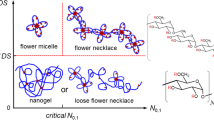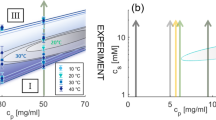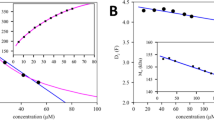Abstract
THE behaviour of proteins1–3, viruses4–7 and cell particles8,9 in aqueous polymer two-phase systems has recently been described. These phase systems consist of water and two water-soluble polymers. Mixtures in water of dextran and methylcellulose, or dextran and polyethylene glycol, are examples of such phase systems. The important characteristic of these systems is their high water content, so that most biochemical substances can be handled in them without denaturation. Each protein or virus particle is distributed in such phase systems in a characteristic manner so that a reproducible partition coefficient is found (partition coefficient, K = concentration of the partitioned substance in the top phase divided by the concentration of the same substance in the bottom phase). The partition coefficient of a particle in a given phase system depends mainly on the surface property of the particle and its size. The larger the size of particle the more unilateral is the distribution. Changes in the size of a protein molecule are reflected in a change in the partition coefficient. For example, the dissociation of Helix pomatia hæmocyanin at certain pH values may be readily followed by measuring its partition coefficient in a dextran–methylcellulose system. Other changes in the structure of a protein molecule, such as the denaturation of serum albumin at low pH values, may cause the protein to move from one phase to the other.
This is a preview of subscription content, access via your institution
Access options
Subscribe to this journal
Receive 51 print issues and online access
$199.00 per year
only $3.90 per issue
Buy this article
- Purchase on Springer Link
- Instant access to full article PDF
Prices may be subject to local taxes which are calculated during checkout
Similar content being viewed by others
References
Albertsson, P. Å., Nature, 182, 709 (1958).
Albertsson, P. Å., and Nyns, Ed. J., Nature, 184, 1465 (1959).
Albertsson, P. Å., and Nyns, Ed. J. (in preparation).
Albertsson, P. Å., and Frick, G., Biochim. Biophys. Acta (in the press).
Frick, G., and Albertsson, P. Å., Nature, 183, 1070 (1959).
Wesslén, T., Albertsson, P. Å., and Philipson, L., Archiv Virusforsch. (in the press).
Philipson, L., Albertsson, P. Å., and Frick, G. (in preparation).
Albertsson, P. Å., Biochim. Biophys. Acta, 27, 378 (1958).
Albertsson, P. Å., Hanzon, V., and Toschi, G., J. Ultrastructure Res., 2, 366 (1959).
Author information
Authors and Affiliations
Rights and permissions
About this article
Cite this article
ALBERTSSON, PÅ., PHILIPSON, L. Antigen–Antibody in Liquid Two-Phase Systems : a Method for studying Immunological Reactions. Nature 185, 38–40 (1960). https://doi.org/10.1038/185038a0
Issue Date:
DOI: https://doi.org/10.1038/185038a0
This article is cited by
-
Liquid sculpture and curing of bio-inspired polyelectrolyte aqueous two-phase systems
Nature Communications (2023)
-
A new multidimensional chromatographic technique: Liquid chromatography with a multiphase eluent
Chromatographia (1982)
-
A rapidα-fetoprotein radioimmunoassay
La Ricerca in Clinica e in Laboratorio (1976)
Comments
By submitting a comment you agree to abide by our Terms and Community Guidelines. If you find something abusive or that does not comply with our terms or guidelines please flag it as inappropriate.



